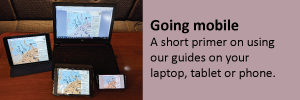Those Roscoe Bay jitters

Looking east from the head of Roscoe Bay toward the entrance from Waddington Channel and to East Redonda Island beyond. (Photo by krad2005)
After opting to “give it five more minutes” about five times to accommodate our six-foot draft and first-timer jitters, we proceeded to squeeze through the narrow passage, slightly favouring the south shore as others had advised us to do.
The extra “five minuteses” were unnecessary. Though the entrance dries at zero tide, the typical 4-5 metre (12-16 feet) tidal range gives even nervous deep-keelers a reasonably wide time window if they hope to enter on a high and rising tide.
On that first visit, late in the year, the bay was empty but for us. Cradled by the steep, forested shores, we felt very alone. First impressions being what they are, we were taken aback on our next visit, finding the bay chockablock with boats.

Chartlet from Salish Sea Pilot’s Cruising Guide to the San Juan Islands. Not to be used for navigation.
Turns out, Roscoe Bay is very popular during high season. It offers excellent all-weather protection and its proximity to Desolation Sound Marine Park just about guarantees it will see lots of traffic.
And this provincial park offers stuff to do, with a nearby freshwater lake for swimming and kayaking as well as hiking trails with splendid views. It’s also known for the mysterious annual congregations of moon jellies which clump together en masse for no clearly understood reason, bound blissfully by some sort of chemical signal.
Anchor in 4-14 metres (12-35 feet) over mud anywhere in the bay. Holding is good, though when busy some late arrivals will anchor on virtually no scope; enough to reach the bottom and not much more. Dragging, apparently, despite the bay’s sheltered nature, is not unheard of.

View down to the anchorage from near the trail to Llanover Mountain. (Photo by Kelsey Crozier)
If you mistime your arrival, in settled weather it is possible to stern tie outside the entrance to await higher water. Some overnight on the outside, perhaps finding it too much trouble to relocate.
It is possible to swim in Roscoe Bay, but BC Parks has issued warnings about high fecal coliform counts here. The bay has poor tidal flushing, and in the past the crush of boats which directly discharged sewage made things unpleasant in the summertime. Federal regulations have outlawed direct discharge, but whether you swim might depend on your level of trust that other boaters are obeying the law.
Instead, from the west end of the Bay is a short trail to Black Lake, which is much larger than Roscoe Bay. Continue up the hill, taking a path to the left to popular swimming rocks. The trail continues to a lookout point for views of the lake.
From a dinghy landing along Roscoe Bay’s north shore, a six-kilometre trail leads up to the summit of Llanover Mountain for views of Desolation Sound. In some places it is very steep. Bring water and good humour.
And you will be forgiven, on the day of your departure, if you let someone else lead the way over the bar.
(Roscoe Bay is covered in Salish Sea Pilot’s Cruising Guide to Desolation Sound.)


















